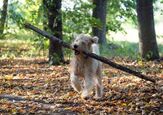What is Scent Work for Dogs?

Are you looking for new activities and events to enjoy with your pup? If so, you may want to explore the world of scent work! It’s a fun and engaging activity that allows your dog to tap into their natural abilities. It’s a great opportunity to build your bond and boost confidence through a rewarding game. If you really love it, there are even opportunities to get involved with scent work on a competitive level!
In this guide, I’ll share everything you need to get started in scent work today, including a better understanding of what scent work involves, the benefits of this game for your dog, and step-by-step instructions to get started with this activity in your own home. What are you waiting for?
What Is Scent Work?
To truly appreciate scent work and the benefits it offers for your dog, we first need to understand the basics. This starts with the instrument at its core: a dog’s nose.
The Master Tool That Is Your Dog’s Nose
Your dog’s nose is more than just an adorable boopable button; it’s a masterpiece of evolution that helps them navigate the world around them. Its power is almost unbelievable! While humans have approximately 5 million scent receptors, our dogs possess 125 million to 300 million, depending on the breed. This means they can experience a world of smells that is far more detailed than anything we can even begin to imagine. They detect odors at concentrations that aren’t even noticeable to us.
In addition to the number of scent receptors, the structure of your dog’s nose improves their powerful smelling abilities. When they breathe in, a fold of tissues separates the air into two distinct pathways: one for breathing and one exclusively for those receptors to detect smells. These two pathways allow them to breathe and analyze scents at the same time.
They also have a specialized organ called a “vomeronasal organ” (or Jacobson’s organ) at the roof of their mouth, which detects specific scents like pheromones and other chemical signals.
When all of this works together, dogs can discriminate and identify individual odors even when they are mixed together with many others. Imagine walking into a busy kitchen filled with the smells of coffee, toast, and bacon. A human nose might just smell “breakfast.” Your dog’s nose, however, can identify the coffee, the specific type of bread, and even differentiate between bacon and sausage. This incredible ability is why scent work is why they are so skilled at detecting specific substances.
The Basics of Scent Work
Scent work is an activity that leverages this incredible power of smell by turning it into a structured search game.
At the heart of scent work is the “target odor.” This is the specific scent that your dog is trained to find. Traditional scent work often focuses on essential oils like birch, anise, or clove, diluted to a specific (and safe to smell) concentration. However, for home-based fun, a target odor can be anything from a high-value treat or specific toy to a unique household item like your car keys. The key is that the dog learns to associate this particular scent with a reward.
It’s also important to note that scent doesn’t just sit still; it moves. As air moves through or over a hidden scent source, it can create a “scent cone” or “plume,” a trail of odor that disperses into the surrounding environment. Dogs are masters at finding and navigating these plums, following the scent back to the source. They learn to identify the strongest point of the scent, which leads them directly to the hidden item.
An important concept to understand in scent work is the difference between the actual source of the smell (where the target odor or item is located) and contamination (residual scent left behind as the item was moved or handled). Through their training, dogs learn to indicate only at the source, ignoring the weaker contamination, but this precision takes time and practice.
At its roots, scent work is a search game. You hide the target odor, and your dog uses their nose to find it. When they do so successfully, they are rewarded. This simple concept is the foundation of all scent work, from casual home activities to competitive trials. The joy for your dog comes from the hunt and the reward. For the handler, the joy comes from watching your dog engage in an activity that is fun and naturally fulfilling.
The Benefits of Scent Work for Your Dog
Scent work is a great way to keep your dog busy (we all know how important that is, especially if you have a young, active puppy or a high-energy dog at home). But it’s more than that! It impacts their mental, emotional, and even physical well-being, helping to give them the best possible quality of life. Here are some of the benefits it offers:
Mental Stimulation and Enrichment
Scent work is often described as a “brain game” because it requires your dog to use their mental abilities, including problem-solving, concentration, decision-making, and memory. Unlike physical exercise, which tires the body, scent work is a form of mental enrichment that tires the mind out in a highly satisfying way. In fact, a dog who has spent 15-20 minutes intensely searching for scents will often be as tired, if not more so, than a dog that has had a long walk!
Many common behavioral problems people face with their dogs, such as destructive chewing, excessive barking, or digging, can be traced back to boredom and a lack of appropriate outlets for their pent-up mental and physical energy. Scent work gives your dog a constructive and engaging activity to channel their energy into, which goes a long way in preventing these unwanted behaviors.
Building Confidence and Reducing Anxiety
For shy, insecure, fear-reactive, or easily startled dogs, scent work can be a game-changer. Each successful find, followed by a reward and enthusiastic praise from you, their person, can help to build a sense of accomplishment. They learn that they are capable and competent at this task, which can translate into greater confidence in other areas of their lives.
For anxious or reactive dogs, scent work also helps by giving them something to focus on, which can have a significant calming effect. The act of sniffing is soothing for dogs, so why not use it to help improve their lives? By engaging their nose and mind in a productive way, nervous energy can then be redirected into a calm, positive activity that helps them feel more secure and less overwhelmed.
Scent work is also an excellent way for dogs to explore new environments, even within their home, by giving them a clear purpose to focus on. It helps to reduce any worries they may have, encouraging them to engage in their surroundings in a positive and goal-oriented way.
Strengthening the Human-Animal Bond
The bond we share with our dogs is special, one that should be nurtured and prioritized in our lives. This is one area where scent work really shines! There is a special joy and satisfaction in watching your dog’s nose go to work, seeing their focus, and celebrating their success together.
Scent work is a team effort. You are the hide-setter, the motivator, and the cheerleader, while your dog is the expert searcher. Working together in this way encourages clear communication and builds a powerful trust between you and your dog as you work together towards a common goal.
As you engage in scent work, you’ll also learn how to better understand your dog, including reading their subtle cues and body language. You’ll recognize when they’re searching, when they’re close to the source or on the right path, and how they indicate a find. This understanding strengthens your bond by allowing for more nuanced communication in all areas of your life.
Physical Exercise (Even for Dogs with Limited Mobility)
One of the great benefits of scent work for those navigating mobility limitations is its low-impact nature. This makes it an ideal activity for senior dogs, you puppies whose joints are still developing, dogs recovering from an injury, or those with long-term physical limitations (like arthritis). It allows you to engage their mind without strenuous physical activity. Active sniffing and searching may not be a high-intensity workout, but it still involves movement, including walking, circling, stretching, and using their bodies to navigate the search area.
Channeling Natural Instincts
Dogs are born sniffers. It’s their most natural and powerful instinct, one that they have a natural desire to engage. Scent work allows them to use these instincts in a constructive, controlled, and highly rewarding way. It also taps into their natural desire to seek, find, and “hunt” for something valuable.
Accessibility for All Dogs
One of the most significant benefits of scent work is that it can be adapted to virtually any dog, regardless of their age, breed, size, or temperament. Whether you have a tiny Chihuahua or a giant Great Dane, a shy rescue or a hyperactive puppy, a senior pup or a high-energy working breed, you can tailor scent work to meet their individual needs and capabilities.
How to Get Started with Scent Work at Home
Getting started with scent work is surprisingly simple and doesn’t require any significant investments. After all, we all love a budget-friendly activity, especially if you’re just trying it out to see if it’s something your pup will enjoy. The key is to make it fun, positive, and to build on your dog’s successes.
Essential Supplies (Keeping it Simple)
As I said, you don’t have to invest in fancy equipment to begin. Here are a few supplies to help you get started:
- High-Value Treats: This is what you will use to motivate your dog, so it needs to be something they love. Choose small, soft, smelly treats. You could use cheese, cooked chicken pieces, or hot dogs. If you prefer a store-bought treat, our dogs love the Vital Essentials Beef Liver Dog Treats.
- Boxes/Containers: Cardboard boxes of various sizes (shoe boxes, tissue boxes, delivery boxes), plastic containers with small holes in the lid, or even rolled-up towels work perfectly for hiding the target scent.
- Leash (for safety, if needed) and a Quiet Space: Begin your scent work in a quiet room with minimal distractions, as it will make it easier for your dog to focus. A leash can be helpful, especially if your dog is prone to wandering or is still learning their recall. We highly recommend a waterproof longline.
- Target Odor Kit (Optional): For more advanced work, or if you’re considering eventually moving on to competitive scent work, you may wish to consider purchasing a beginner kit like the Leerburg AKC Scent Work Kit.
Phase One: Build the Basics with Treat Searches
Start by teaching your dog that using their nose to find a scent leads to rewards. Start easy, letting them see you hide a treat under a cup or fabric. Give a cue like “Find it!” and cheer them on as they succeed. As they become more confident, step up the challenge by hiding their treats in slightly trickier spots, like behind a door or under a cushion. You can also try hiding a few treats around the room, allowing them to search for all of them. But don’t forget to cheer and celebrate each find!
Phase Two: Introduce a Target Scent (Optional)
This phase isn’t necessary; hide and seek treat searches around the house may be the perfect way to enjoy scent work for you and your pup. However, if you want to go a step further, you can teach your dog to find a specific scent.
To begin, pair the scent with a reward by using a drop of essential oil (like birch) on a cotton swab next to a treat. Hide it and use your search cue. As your dog begins to associate the scent with the command, you can gradually increase the distance between the scent and the treat so your dog learns to target the scent. Always praise and reward your dog right where they find the scent, so it reinforces that the celebration is connected with the scent.
Phase Three: Step Up the Search Game
Once your dog understands the concept, you can turn this into a full game by changing the environment. Here are a few fun ways to do that:
- Container Searches: Use identical boxes, hide the scent in one, and add more boxes or "distractors" over time.
- Indoor Searches: Hide scents in different rooms and places (under cushions, on shelves, behind curtains).
- Outdoor Searches: Try scent games in your yard, hiding the target under leaves, on trees, or around furniture. Consider wind and weather when placing hides.
Exploring Formal Scent Work
If you and your dog really enjoy scent work, you may want to get involved in more formal opportunities. Many dog training facilities will offer scent work classes or workshops. Professional guidance can help refine your dog’s skills, introduce new concepts, and prepare you for more advanced searches. You can also explore organizations like the National Association of Canine Scent Work (NACSW) or the American Kennel Club (AKC), which offer titles and competitions. Not only is this a fun way to level up your scent work efforts with new challenges, but it also introduces you to a fantastic community.
Start Your Journey with Scent Work Today
Scent work is an incredibly powerful and accessible way to give your dog a life that is not just comfortable, but truly fulfilling. By engaging this powerful sense, you’re not just playing a game; you’re providing mental enrichment, boosting their confidence, reducing anxiety, and strengthening that incredible bond you share. What’s not to love?
Join the PetGuide community. Get the latest pet news and product recommendations by subscribing to our newsletter here.

Britt Kascjak is a proud pet mom, sharing her heart (and her home) with her “pack” which includes her husband John, their 2 dogs – Lucifer and Willow – and their 3 cats – Pippen, Jinx, and Theia. She has been active in the animal rescue community for over 15 years, volunteering, fostering and advocating for organizations across Canada and the US. In her free time, she enjoys traveling around the country camping, hiking, and canoeing with her pets.
More by Britt
























